COVID-19 has had a profound effect in every walk of life, and businesses have faced severe effects from the pandemic. But, as industries are resuming operations, they are adapting to the new normal where safety measures, sanitation at the workplace, and keeping an eye on health of employees makes the key difference in tackling challenges posed by the virus.
Murphy Oil (NYSE: MUR) also has implemented measures required to help keep COVID-19 infections at bay with employees by diligently monitoring open-source COVID-19 data to study metrics (Fig. 1) such as number of active and new cases, hospital bed capacity with COVID-19 related cases, intensive care unit (ICU) bed occupation rates with COVID-19 related cases, and measuring average of fewer than 15% general population compared to ICU beds occupied by COVID-19 patients in all regions with company offices, especially US and Canada, on a daily basis and implementing a mandatory screening of any staff or visitors before entering a Murphy-operated site.

Implementation and Effect
Moving into action and monitoring the COVID-19 outbreak since January, following initial reports from China, worked in favor of Murphy Oil. Observing media reports from across the globe on a regular basis provided an estimate of the potential effect the pandemic could have on the company’s global operations as well as businesses in the United States. Tom Mireles, senior vice president of technical services at Murphy, said, “It was important for us to learn as much about the spread of COVID-19 as possible in the early days before the US or Canada even had its first case so we could recognize the potential risks from the super spread of events and assess impact to our operations, especially our offshore facilities. Will we need to shut in production? How much loss in revenue does this mean?” Fig. 2 illustrates Murphy’s ability to track new cases in all of Murphy’s operating regions.
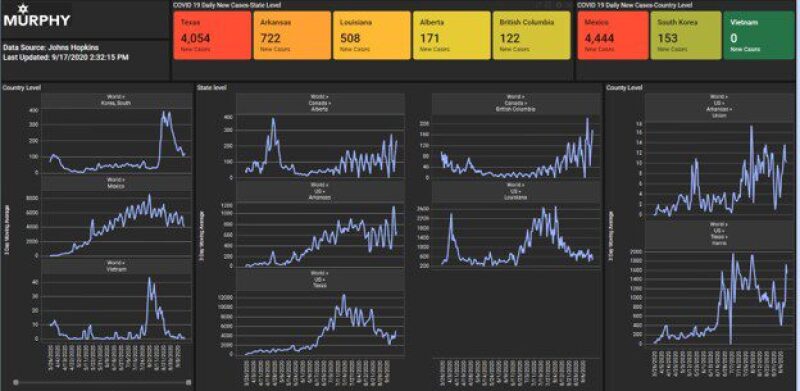
Tracking this data enabled Murphy to predict and prepare for a potential government-mandated lockdown or a worst-case scenario where an employee on site contracted COVID-19. Very early on, Murphy realized that, in addition to ensuring that all people present at site wear protective gear, including face masks, they needed to establish a screening process as another safety measure. This diligent screening process first started with the offshore employees who were required to take antibody tests upon arrival at the helipads before going offshore.
To further leverage the data within Canada and the US, analytics were run at a ZIP-code level to capture COVID-19 hotspots and assess risk of spread among employees based on their ZIP codes. Mireles said, “After Mardi Gras, we saw a spike in cases in Louisiana where a lot of our employees reside, so we utilized ZIP-code-level data to identify risk of spread within employees based on their location and recognized their tendency to carpool offshore as a big contributor to spread.”
Meanwhile, the screening process for the offices would encompass a simple questionnaire to record information which can help track a person’s whereabouts and their proximity to anyone infected with COVID-19 within 14 days. This was important, especially in Harris County, considering its poor Social Distancing Score (Fig. 3). It would then need to ensure that the worker hasn’t experienced any symptoms indicating COVID-19 infection or a fever, which is a common sign of the virus.
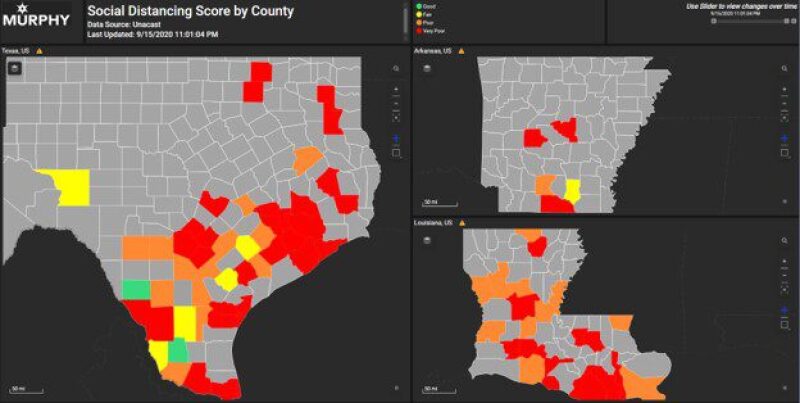
Going Digital To Increase Efficiency and Reduce Risks
The screening solution would need to be efficient to avoid overcrowding at entry points, and risk of infection for the person conducting the screening remained a challenge. Therefore, the safest screening method was through virtual means. Gil Martinez, senior emergency response specialist at Murphy, said, “The best way to do it was virtually and through an app. People can verify (their) own temperature and fill a questionnaire.”
Talking about several potential solutions that were considered, Martinez added, “One had 20 questions, which took too long to answer, just to enter the building. And, in the other possible solution, the way data was being stored was also a concern and unnecessarily complicated the process.”
The company decided to develop an in-house application using Microsoft PowerApps called the Site Tracker, which has a simplified interface and ensures infected workers don’t pose a danger to others employed during check in because that would threaten to interrupt operations. Martinez said deciding which questions to ask and which would take minimal time and effort to answer was a challenge. Fig. 4 summarizes the key questions narrowed down by the team based on key metrics they were monitoring and guidelines from the World Health Organization (WHO) and the US Centers for Disease Control and Prevention (CDC).
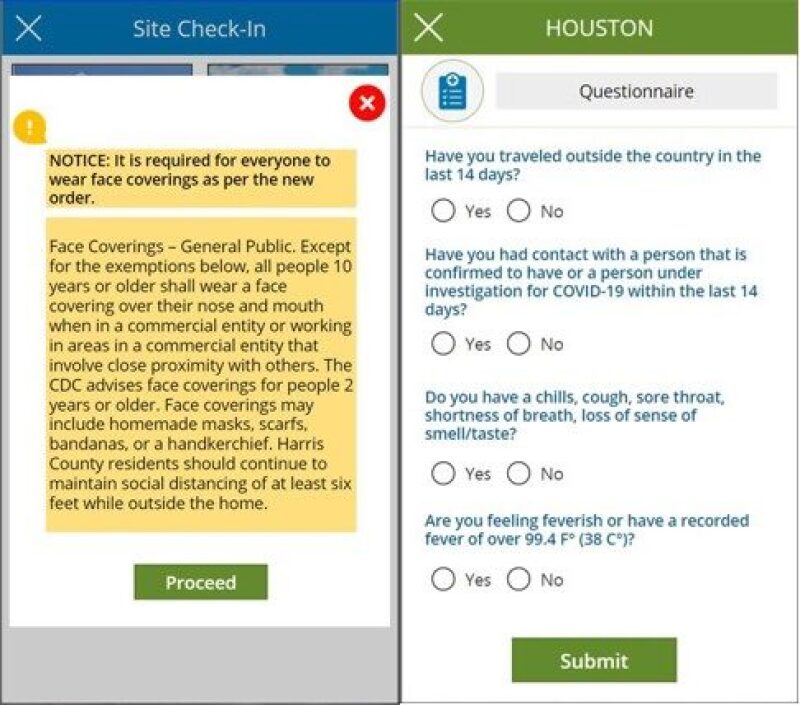
The next step was the human resources department reviewing data collected from employees through the app and comparing it with daily access cards of those checking in. If someone who had mentioned having symptoms or being close to an infected person had accessed the site, then that was identified through the app and addressed. The Site Tracker app was implemented before state-mandated lockdown, during which more than 100 employees were screened daily. Now at minimal capacity, the app screens 10 employees daily. Mireles said the biggest challenge of using this app was getting into the behavior of using it. The doors are not policed, so, until people get into the habit of using it, Murphy will need to monitor app data diligently to ensure all personnel who have entered the building have answered the questionnaire.
An Essential Resource
With four direct questions and simple safety measures mentioned on the app, Site Tracker is crafted to finish the screening process on sites efficiently, consistently, and in as little time as possible. The swift process does not cause any interruption to the day-to-day operations and, thus, ensures maximum productivity at the sites while establishing top safety standards.
Other than simply reducing the time workers have to spend answering COVID-19 related queries before entering the offices, the tracking app also integrates informative guidelines from the WHO and other experts on what to do if one experiences symptoms (Fig. 5). With complete solutions from recording a person’s check-in at a site to issuing guidelines and tracking their health, Site Tracker has enabled the company to move ahead with business operations without risks caused by COVID-19.
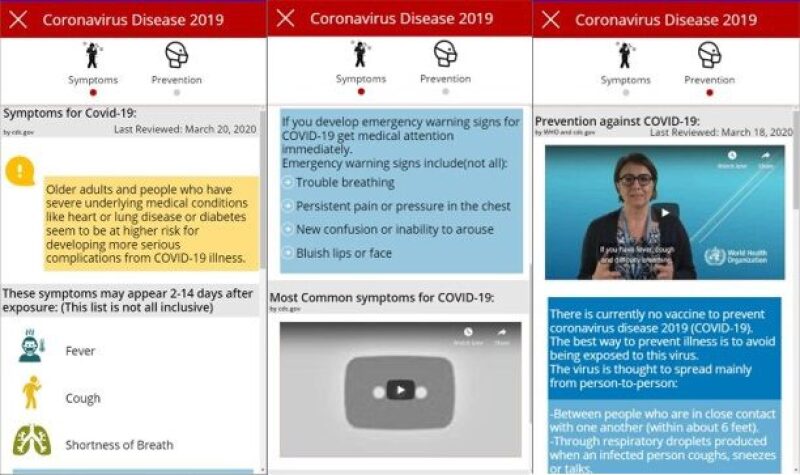
Apart from smooth functioning of operations at units and offices in times of a global pandemic, the survey conducted by Site Tracker also can be useful for keeping an eye on the rise of infections. Updating the app with the latest data about COVID-19 symptoms and causes of infection can help strengthen safety at sites by recommending the most effective measures to sanitize Murphy’s buildings.
The outcomes of these checks are in line with Murphy Oil’s policy of creating a safe and healthy environment at the workplace while contributing to the community’s well-being.
Facilitating Quick and Informed Decisions
David Rainwater, manager for global security and emergency response at Murphy, said he sees the Site Tracker app as an important source of data that can be passed on to high-level executives. The top management can go through the tabulated and organized information about COVID-19 among workers on sites and then weigh the risks and opportunities for moving forward with operations.
Describing Site Tracker as a good insurance for future course of action, Rainwater said, “They definitely can use the app and leverage it to deal with emergency response in the future or even to deal with any type of crisis, whether a natural disaster or another health crisis.”
He describes access to regularly updated data to guide the firm and employees as his favorite feature on the app. “Even with work-from-home orders,” he said, “the employees are guided properly and equipped with recent COVID-19 data.”
Staying a Step Ahead
The Site Tracker addressed the need to supply data up the management ladder to executives, who could act early on policies about bringing people back to the office or instructing them to work from home. The chief executive was also informed about regular updates on local infection rates so that the best choices can be made with the safety of the employees as a priority (Fig. 6).
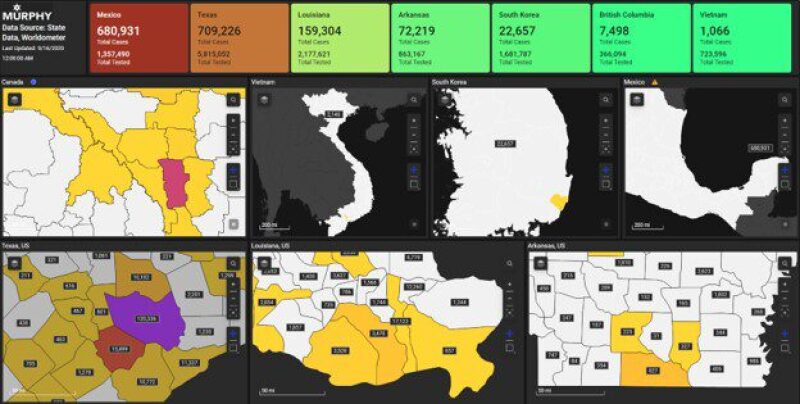
The pandemic and ensuing lockdown has been an unexpected jolt for the global economy, bringing many industries to a halt. Oil exploration across the world also has been affected by travel restrictions as well as fluctuating demand in other sectors. Murphy Oil has taken a step forward into a digital future by designing and implementing an app that is easy to use, quick, convenient, and asks simple questions that bring out accurate answers. The surveys are straightforward, and the data can be interpreted easily and compared with on-field information to help managers address issues even while working from home.
While real-time data will help Murphy create a flexible strategy to increase productivity despite the threat of COVID-19 infections, it will also be stored for future reference. Once the COVID-19 crisis has subsided, the information from Site Tracker can be processed, analyzed, and used for devising an action plan to be prepared for any such health emergency or disaster that may hit the industry in the future.
With more than 3,000 people directly and indirectly working for Murphy Oil across the globe in Asia, Australia, and North and South America, the company must take stock of the potential threat in any part of the world. Mireles recognized that tracking this data enabled a customized response to how each North American office needed to be managed. “We had to consider where our offices were and how COVID-19 was unfolding in those areas, specifically Houston, Calgary, El Dorado, and offshore facilities,” Mireles said. “We couldn’t just form a blanket response for everyone. El Dorado, Arkansas, did not experience COVID-19 the way we did in Houston, for example. They reopened offices before Houston did because Houston was much worse.”
Having data from a pandemic of COVID-19’s scale can help the company get an accurate idea about risks in coming years and the safety measures that are to be implemented according to the virus’s impact in various locations (Fig. 7).
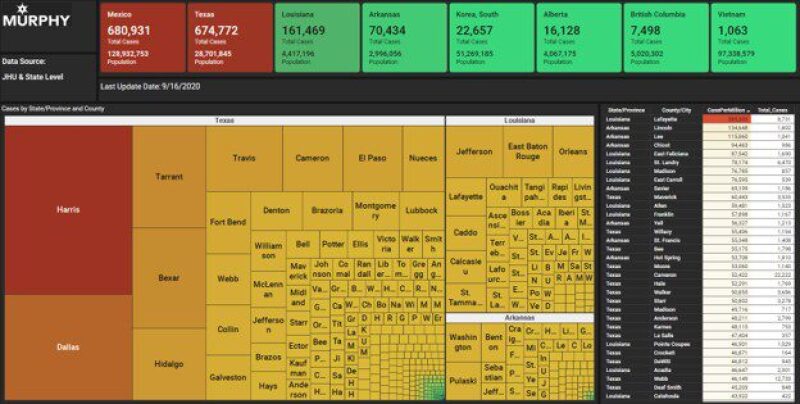
Getting Ready for a Data-Driven Future
Global experts and the WHO have acknowledged that the world needs to learn to live with the pandemic, and Murphy Oil is collecting data to adapt. Technology is the way forward, and staying informed to stay ahead of any future outbreak will ensure that the company maintains the highest standards of workplace safety while contributing to a healthy community wherever it operates.
Site Tracker app data also can lead to understanding the different effects on the company’s operations in different geographies and help Murphy study the response of different governments to contain the outbreak. Analyzing past data as well as real-time updates will help executives decide the number of workers to be present at a particular site and which exploration operation should be in focus to bring out maximum production with the lowest risks. Moreover, data collected from employees and information about local trends will be the key factor in deciding which offices can be reopened and how many employees can be called back to offices with the necessary precautions.
Reports about hospital capacity and data on infections or symptoms among the staff can be compared to determine the safety of increasing the number of employees working at a specific site or office. The Site Tracker app thus acts as a consolidated source of all the information that the company needs to effectively manage security, health, and productivity.
Thinking out of the box and relying on a data-driven approach paired with a virtual, app-based survey methodology opened doors for Murphy to tackle a global health crisis. While field operations remain the basis of the company’s functioning, digital tracking and screening procedures have given it immunity against the threat of an outbreak that posed a serious hindrance to its global oil exploration.
Sources for Data in Dashboards
Texas Department of State Health Services
Georgia Department of Public Health
Louisiana Department of Health

